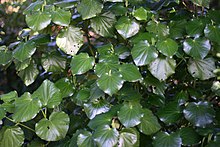Macropiper excelsum
| Kawakawa | |
|---|---|
 |
|
| Scientific classification | |
| Kingdom: | Plantae |
| (unranked): | Angiosperms |
| (unranked): | Magnoliids |
| Order: | Piperales |
| Family: | Piperaceae |
| Genus: | Piper |
| Species: | P. excelsum |
| Binomial name | |
|
Piper excelsum (G.Forst.) Miq. |
|
Piper excelsum (formerly known as Macropiper excelsum), called Kawakawa, is a small tree of which the subspecies M. excelsum subsp. excelsum is endemic to New Zealand; the subspecies M. e. subsp. psittacorum is found on Lord Howe Island, Norfolk Island and the Kermadec Islands
It is found throughout the North Island, and as far south as Okarito (43.20 °S) on the West Coast and Banks Peninsula (43.5 °S) on the east coast of the South Island. The leaves are often covered with insect holes. The images depict the variety majus which has larger and more glossy leaves than P. excelsum. The name Kawakawa in Māori refers to the bitter taste of the leaves, from kawa bitter.
The Kawakawa leaves are about 5–10 cm long by 6–12 cm wide; they are opposite to each other, broadly rounded with a short drawn-out tip and are heart-shaped at their bases. The leaves are deep green in color if growing in the forest but may be yellowish-green when growing in more open situations.
The flowers are produced on greenish, erect spikes that are 2.5-7.5 cm long. Kawakawa flowers are quite minute and very closely placed around the spike. After pollination the flowers gradually swell and become fleshy to form small, berry-like fruits that are yellow to bright orange.
Each berry cluster is the size of a small finger . Ripening period is January and February. These fruits are favoured by kereru, or New Zealand pigeon (Hemiphaga novaeseelandiae) and tui (Prosthemadera novaeseelandiae).
Kawakawa is a traditional medicinal plant of the Māori. An infusion is made from the leaves or roots, and used for bladder problems, boils, bruises, to relieve pain or toothache, or as a general tonic. The sweet edible yellow berries (most often found in summer on female trees) of the plant were eaten as a diuretic.
It also is important in cultural contexts: host people of a marae wave leaves of kawakawa to welcome guests. At a tangi, both hosts and guests may wear wreaths of kawakawa on the head as a sign of mourning.
...
Wikipedia
